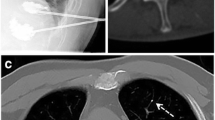Abstract.
We assessed radiographic and functional outcome in 13 patients with a minimum of 5 years follow-up from a prospectively monitored series of 17 patients who underwent percutaneous vertebroplasty (PPV). A visual analogue scale (VAS) and the short McGill questionnaire (MPQ) were used to assess average symptoms. The VAS showed significant improvement after treatment: the initial score was 9.07±0.6 (mean±SD), falling to 2.07 (1.14) on the third day, 1.07 (1.07) by the third month and 2.15 (2.6) at 5 years. Pain reduction was statistically significant (P<0.001). The MPQ showed a significant improvement after treatment (P<0.001), but had worsened by the last follow-up. All patients were "very" or "somewhat satisfied" with the procedure. We saw no further collapse of the vertebrae injected or migration or changes in the shape of the cement. A new fracture was seen in three patients, affecting four vertebrae, only two of which were adjacent to the treated level. On CT following the procedure, there was cement in the epidural veins adjacent to the vertebra in 48% of cases, but only patient developed a transitory neuritis.
Similar content being viewed by others
Author information
Authors and Affiliations
Additional information
Electronic Publication
Rights and permissions
About this article
Cite this article
Pérez-Higueras, .A., Alvarez, .L., Rossi, .R. et al. Percutaneous vertebroplasty: long-term clinical and radiological outcome. Neuroradiology 44, 950–954 (2002). https://doi.org/10.1007/s00234-002-0856-1
Received:
Accepted:
Issue Date:
DOI: https://doi.org/10.1007/s00234-002-0856-1




